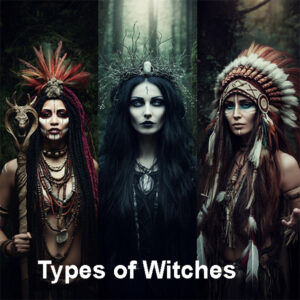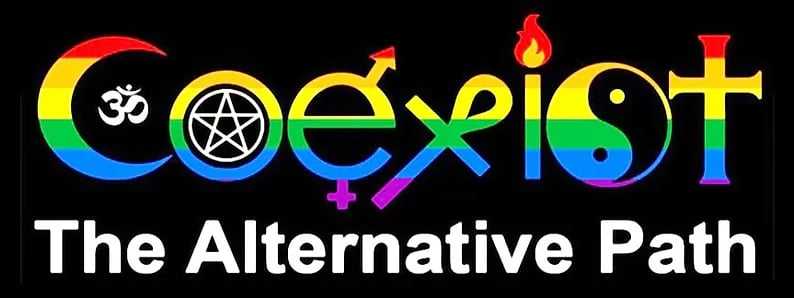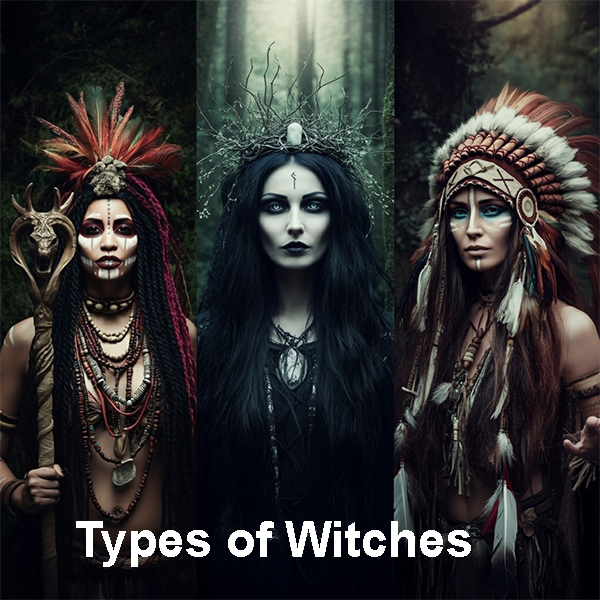As diverse as anything else, types of witches vary by culture and path. Witchcraft. It’s one of those words that’s been misunderstood, feared, and twisted for centuries. From ancient history to today, witches have been part of almost every culture. And we’ve always had many names. So, whether you’re curious about witchcraft or already practicing it, let’s explore the types of witches. Trust me, it’s going to be fun.
Types of Witches: From Bruja to Völva
 Witches go by many names, depending on where you’re from. In Spanish-speaking cultures, bruja (female) and brujo (male) just mean “witch.” These witches carry deep roots in spiritual practices like Macumba, Yoruba, and Voodoo. The term Voodoo itself became popular in Louisiana in the 1800s, with roots in West African traditions. You may also see it written as vodou, vodun, or voudou.
Witches go by many names, depending on where you’re from. In Spanish-speaking cultures, bruja (female) and brujo (male) just mean “witch.” These witches carry deep roots in spiritual practices like Macumba, Yoruba, and Voodoo. The term Voodoo itself became popular in Louisiana in the 1800s, with roots in West African traditions. You may also see it written as vodou, vodun, or voudou.
Let’s not forget Hoodoo. This is a practice that emerged from enslaved African Americans in the Southern U.S. Hoodoo blends African spiritual traditions with indigenous botanical knowledge. It focuses on practical magic for everyday life. If you’ve ever used herbs or roots for healing, you’ve dabbled in something like Hoodoo.
And throughout history, witches have existed in almost every culture. The Norse völva (priestesses) and Celtic witchcraft or Druids come to mind. Native American medicine people also played key roles. Witches weren’t just a side gig—they were essential. “Vrăjitoare”: This is the direct translation of “witch” in Romania. The Magi practiced Egyptian magic. Though some would not refer to themselves as witches how about those that practice Santeria or Santa Muerte? There’s also Wica (wise ones) not to be confused with Wiccan and a Scottish witch.
We have a lot of occult books on many paths of witchcraft in our physical store, come visit! Connect with us for more on Instagram, Facebook (Meta) or TikTok.
Types of Witches: It’s More Than Just “Witchy” Labels
Let’s be clear: there’s no single definition of a witch. Some witches call themselves green witches, shamans, or even hedge witches. And guess what? The Craft welcomes tall types of witches. Whether you want to manifest your desires or conjure a spell, you can pick the type that suits you. Magic is like a buffet—take your pick.
The Green Witch: Earthy, Botanical, and Magical
A green witch is someone who connects deeply with nature, especially plants and herbs. These types of witches do not mean they wear green (though that would be fun). It’s about feeling that Earth energy. If you’re someone who loves being in nature or enjoys gardening, you might be a green witch. Green witches use herbs for healing, potion-making, or spell-casting.
Historically, these witches were often healers and wise folk. They passed down knowledge of plant magic and remedies. From lavender to mugwort, they knew their herbs. If you’ve ever made a magical tea or potion, you may be walking the green witch path.
The Hedge Witch: Between Worlds
Now, if you’re more of a lone wolf who prefers solitude, the hedge witch might be your vibe. The term hedge symbolizes the boundary between the physical world and the spiritual one. These types of witches are experts in divination, astral travel, and tapping into unseen energies. They often work beyond the “hedge” or edge of reality.
Hedge witches like to work alone. They use practices like meditation and lucid dreaming. They may also use plants that alter consciousness to journey into different planes. These witches focus on personal, private magic. They rely heavily on intuition and psychic abilities to manifest their desires.
In the old days, people who sought help from cunning folk were often looking for a hedge witch. So yes, witches were also known as “cunning folk.”
The Shaman: An Ancient Path of Healing
Shamans are also types of witches and another term that often gets lumped in with witch, but they aren’t quite the same. Shamans act as spiritual healers, bridging the gap between the physical and spiritual worlds. You’ll find them in many Indigenous cultures, from Siberia to Native American tribes. Shamans access spiritual knowledge through rituals, drumming, and trance work.
Unlike other witches, shamans don’t usually practice magic for personal gain. They’re focused on maintaining the balance between nature and spirit. Shamans often perform healing rituals, offer spiritual guidance, and mediate disputes. If you feel a deep connection to the spirit world and want to help others, you might find your path as a shaman.
The White Witch, Black Witch, and Gray Witch: Magic and Morality
Some types of witches define themselves by their moral compass. The white witch is seen as a practitioner of “good” magic—healing, protection, and blessings. The black witch, on the other hand, might focus on darker arts like cursing or hexing. But, and here’s the kicker, not all black magic is evil.
Then there’s the gray witch, who occupies the middle ground. These witches use magic for both good and bad, depending on the situation. They believe that sometimes, magic must balance out injustice. Personally, I think the line between white, black, and gray is blurry. We all have our dark moments, don’t we?
The Lunar Witch: Under the Influence of the Moon
Ah, the moon. If you feel drawn to the lunar cycle, you might be a lunar witch. These types of witches align their magic with the phases of the moon. For example, a new moon is great for setting intentions. A full moon, however, is perfect for powerful spells and deep spiritual work.
Lunar witches believe the moon’s energy amplifies their magic. The moon affects the tides, plant growth, and even our emotions. If you’ve ever felt a pull toward the moon, you’re not alone. Many witches and pagans throughout history have honored the moon and its deities.
The Witch Doctor: Root Work and Healing
In African and Caribbean traditions, witch doctors or root workers use herbs, roots, and charms for healing. Root work blends folk medicine and magic. These witches focus on energies surrounding illness, health, and protection.
Witch doctors also act as community counselors. They guide people through life’s challenges and offer protection from negative energies. Their work is rooted in spiritual healing and the metaphysical properties of plants and rituals. If you’re drawn to healing with natural elements, you may find a path in root work.
The Wiccan Witch: A Modern Take on Ancient Magic
Wicca is one of the most popular modern forms of witchcraft. Wiccans follow the Wiccan Rede, which says, “An it harm none, do what ye will.” It’s a philosophy of personal freedom while minimizing harm to others. Wiccans worship nature and honor the divine feminine. Check out some Wicca related books.
Though Wicca has roots in ancient paganism, it’s a relatively modern practice. Wicca emerged in the 20th century, with its own rituals, spells, and Sabbats. These celebrate the changing seasons. If you love structured spiritual practices and metaphysics, Wicca might appeal to you.
Wrapping It Up: Which Type of Witch Are You?
So, which type of witch are you? Are you drawn to herbs and plants? Or do you feel a strong connection to the moon? Perhaps you’re a hedge witch who prefers solitary spiritual practices. Whatever your type, remember: witchcraft is as diverse as its practitioners.
Magic is all about energy, and how we work with it defines our path. Whether you’re casting spells for good, cursing a wrongdoer, or simply exploring metaphysical energies, there’s no wrong way to be a witch. The Craft is not just about spells—it’s about growth and spiritual connection. So, embrace your path. Whether it’s green, lunar, or gray, being a witch is about living in harmony with the energies around us. Me? Well hell, I always just refer to myself as a plain old witch. If you would like an in-person reading or If you are far, an online tarot reading with me or one of my coven, book one today.






I dont get why everyone is so obsessed with categorizing witches into different types. Cant we all just embrace the magic and uniqueness of each individuals practice without putting them into boxes? Live and let live, people!
I feel that Aryan – I think modern humans have this compulsion to categorize everything. While I did attempt to explain to seekers, there are different “types” of witches, I don’t think any one of them truly fits 100% in any “box”.
I’m still learning, but as I grow I learn a little more about the different types of witch. I hope to continue to be a little of each type and be eclectic. Thanks for the enlightening explanation of the different types. Very helpful.
🙂 If it helps, I always tell people “just a plain ol witch here”, because it’s true. I do kitchen witchery, hedge witchery, I love working with fire but I work with all the elements. In short, call me eclectic too, nothing wrong with that. Sometimes I think the world is consumed with having to ultra-label every little thing. I encourage people not to try and define it so hard, just be you and work with what resonates with you dear. Blessings!
I’m new at all this I just know I’m different and have strange dreams ,love nature try to show kindness to all. I have abilities just don’t know what to do with them. My uncle calls me a seer my parents forbad me to draw I couldn’t explain what I drew. I don’t fear animals so am a bit confused as to what I am I don’t like seeing humans getting hurt or animals.
Hello dear Syliva – 🙂 My first advice to you is to be yourself, always. Sometimes we have to be discreet, but we never want to live a lie to appease others. Secondly, with abilities, what do you see around you that is incorrect? Not helpful or even harmful. Bend your thoughts, will and practice to remedying some of those. That’s a lovely place to start. Blessings!
I never knew there were so many types of witches! I always thought it was just good witches and bad witches like in movies. Its cool to learn about all these different aspects of the craft.